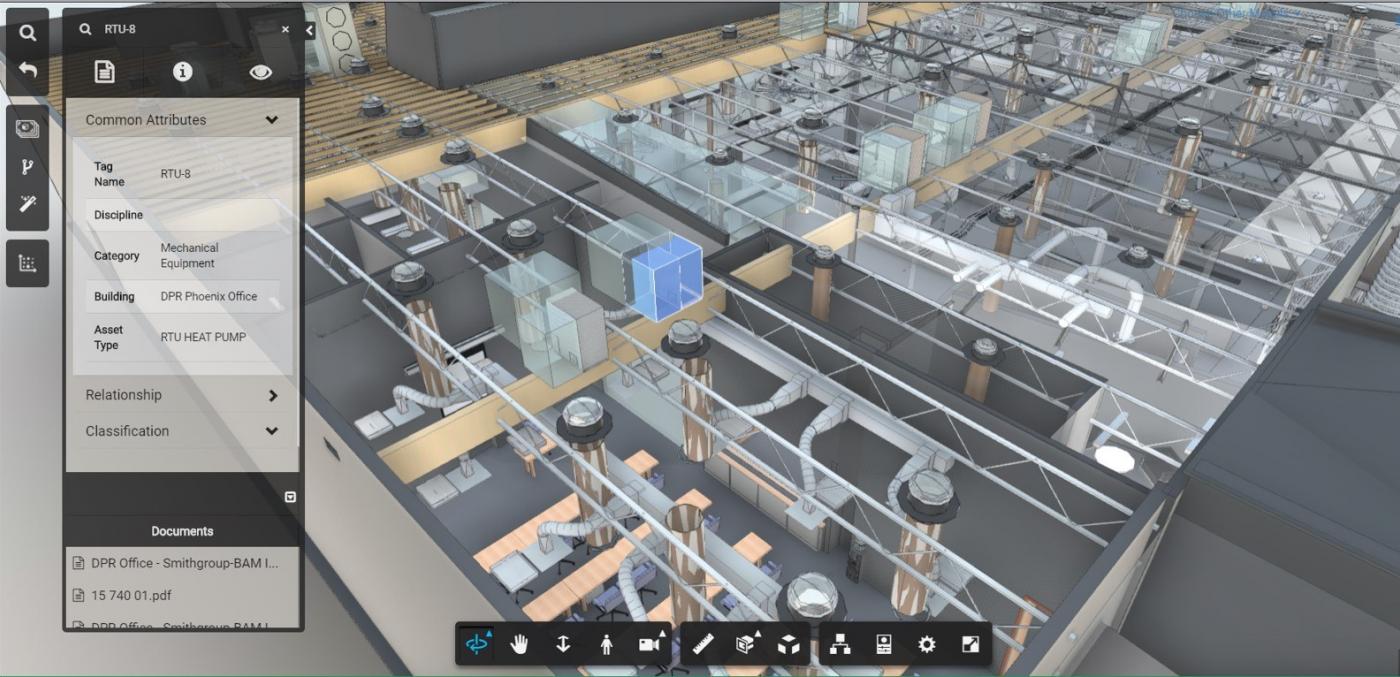Extending VDC Beyond the Jobsite to Operations

There has been a fundamental shift to help teams extract valuable facilities management data from design and construction and turn it into building intelligence. By utilizing Virtual Design and Construction (VDC) techniques, teams can execute strategies to keep a building’s dataset accurate to streamline facility management (FM) processes, improve operational workflows, increase efficiency, and prevent downtime.
Putting VDC to use beyond the construction site allows those responsible for maintaining the building to quickly locate themselves, see a digital view of what the final and actual design is for the space and quickly handle issues, ideally with the help of mobile software platforms.
Improving Understanding
A robust VDC program through the project lifecycle lets teams focus on critical assets that affect the lifecycle of the build, including architectural and mechanical, electrical, and plumbing (MEP) systems. This strategy improves the understanding of operational needs by project teams. It identifies scope for information requirements, and improves the process for authoring, verifying, and transferring the information into your current systems – all while considering the workflows of design and construction stakeholders. Facility managers will request maintenance manuals, warranties, parent/child relationships of equipment and more.
“The power of seeing the details of proposed work immediately, when you need it, solves for many challenges that teams on the front lines face,” said Adam Rendek, BIM/ Engagement Manager, VueOps. “Quick, intuitive and comprehensive communication solves the ‘I need this information right now’ request that jobsites face daily.”
VueOps® provides expertise in BIM-FM through a software as a service (SaaS) to help teams extract valuable facilities management data from design and construction and turn it into building intelligence.
To ensure the most benefit to operations, building owners and teams should start well before substantial completion of the build to identify and discuss clear goals for operation. Taking the data in context, teams can be organized to help maintain the continuity that is relevant to operations.
But no matter where businesses are in the design and construction process, planning and executing strategies to keep a building’s dataset accurate will directly influence cost savings and operational efficiency in the long run. It can also be done at any stage.
Moving from VDC to VueOps
With VueOps, a team of subject matter experts support owners, facility managers and key stakeholders on the design and construction journey. The goal of the effort is to improve overall data quality of the models, drawings, and documents.
VueOps connects projects documents, asset data, models, and spaces to help answer the time critical questions of “what” (assets), “where” (space, floor), and “how” (how to access and tools required.)
By leveraging VDC – which most customers are already paying for as part of construction services – with an engaged partner like VueOps, owners have the potential to get more value for their VDC dollars and ensure that critical information from design and construction is prioritized and delivered in a way they can use from day one.
When it comes to a virtual representation of the build, DPR Construction has been pushing the envelope on this for years. In Integrating Project Delivery by Martin Fischer, Howard W. Ashcaft, and DPR’s Dean Reed and Atul Khanzode, the authors highlight how buildings have become more technically complex, the regulations that need to be considered more multifaceted, and the social and business expectations and pressures more intense.
The increased technical complexity and the multifaceted regulatory constraints require the inclusion of experts that understand the specific technical systems to project teams. This increased specialization has led to fragmented project delivery, in part because the project management tools used on many projects are good at dividing the work up into chucks but less good at making sure the everyone’s work fits together. The increased business and social pressures on building performance, however, demand a strategy to overcome this fragmentation, a strategy to integrate project teams and their work. To overcome this, the project team becomes a virtual enterprise. People stop working in silos and exchange information frequently instead of periodically.
“I think everyone knows the cost of operating Buildings far exceeds the cost it took to build them,” says Hannu Lindberg, VDC leader at DPR. “The key to getting maximum value for the capital investment is streamlining the handover process from construction to operations. Managing daily operations by using BIM for FM assets created during construction provides incredible insights of the building function and its systems, unlocking the initial capital investments to be used for building operations and maintenance.”


